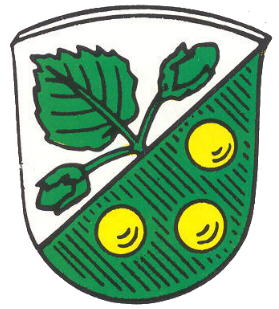Höslwang: Difference between revisions
Jump to navigation
Jump to search
Knorrepoes (talk | contribs) m (Text replacement - "/Arms of " to "/Arms (crest) of ") |
Knorrepoes (talk | contribs) m (Text replacement - "{{media}}" to " {{de1}} {{media1}}") |
||
| Line 22: | Line 22: | ||
The name is derived from Hasel-, or hazel. The upper half thus shows a hazel branch with two hazelnuts. The lower half shows three golden balls, the symbol of St. Nicolas, the patron saint of the village. | The name is derived from Hasel-, or hazel. The upper half thus shows a hazel branch with two hazelnuts. The lower half shows three golden balls, the symbol of St. Nicolas, the patron saint of the village. | ||
{{ | |||
{{de1}} | |||
{{media1}} | |||
[[Civic Heraldry Literature - Germany|'''Literature''']]: Information provided by the Höslwang council | [[Civic Heraldry Literature - Germany|'''Literature''']]: Information provided by the Höslwang council | ||
Revision as of 11:15, 26 December 2022
This page is part of the German heraldry portal |
Heraldry of the World |
|
German heraldry:
|
Selected collector's items from Germany:
|
HÖSLWANG
State : Bayern
District (Kreis) : Rosenheim
| German | |
| English | No blazon/translation known. Please click here to send your (heraldic !) blazon or translation |
Origin/meaning
The arms were officially granted on January 2, 1968.
The name is derived from Hasel-, or hazel. The upper half thus shows a hazel branch with two hazelnuts. The lower half shows three golden balls, the symbol of St. Nicolas, the patron saint of the village.
Literature: Information provided by the Höslwang council


